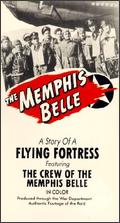World War II Documentary - The Memphis Belle: A Story of a Flying Fortress
|
|
|
|
 |
 |
Directed by - William Wyler
Produced by - First Motion Picture Unit of the United States Army Air Forces
Written by - Jerome Chodorov and William Wyler
Starring - The crew of the Memphis Belle
Music by - Gail Kubik
Cinematography - Harold J. Tannenbaum and William H. Clothier
Distributed by - Paramount Pictures Inc
Release date(s) - 1944
Running time - 45 min
Language - English
The Memphis Belle: A Story of a Flying Fortress is a 1944 documentary film which ostensibly provides an account of the final mission of the Memphis Belle, a B-17 Flying Fortress. In May 1943 it became the first U.S. Army Air Forces heavy bomber to complete 25 missions over Europe and return to the United States [1].
The dramatic 16 mm color film of actual battles was made by cinematographer First Lieutenant Harold J. Tannenbaum. The film was directed by Major William
Wyler, narrated by Eugene Kern, and had scenes at its Bassingbourn base photographed by Hollywood cinematographer Captain William H. Clothier. It was
made under the auspices of the First Motion Picture Unit, a branch of the United States Army Air Forces. The film actually depicted the next to last
mission of the crew (see below) on May 15, 1943, and was made as a morale-building inspiration for the Home Front by showing the everyday courage of
the men who manned these planes.
Cast
The crew on the missions filmed included:
- Captain Robert K. Morgan (pilot)
- Captain James A. Verinis (co-pilot)
- Captain Vincent B. Evans (bombardier)
- Captain Charles B. Leighton (navigator)
- Technical Sergeant Robert J. Hanson (radio operator)
- Technical Sergeant Harold P. Loch (engineer and top turret gunner)
- Staff Sergeant Casimer A. Nastal (waist gunner)
- Staff Sergeant Clarence E. Winchell (waist gunner)
- Staff Sergeant Cecil H. Scott (ball turret gunner)
- Staff Sergeant John P. Quinlan (tail gunner)
Morgan's crew had not flown all of its missions together. Captain Verinis had originally been Morgan's co-pilot at the beginning of their combat tour but had become a "first pilot" (aircraft commander) in his own right on December 30, 1942, after which he flew 16 missions as commander of a replacement B-17 he named Connecticut Yankee after his home state. Verinis finished his tour two days before the rest of Morgan's crew.
Nor was Morgan's crew the one originally selected by Wyler for filming. He had been following Captain Oscar O'Neill (whose plane was named Invasion 2nd) of the 401st Bomb Squadron until O'Neill's B-17 and five others were shot down over Bremen, Germany, on April 17, 1943. Morgan was then selected and his crew re-united by the Eighth Air Force to complete its tour together and to return to the United States for a war bond drive. Wyler also informed Morgan when asked that had the Memphis Belle been shot down on the crew's final mission, Wyler had a backup crew working with another B-17 about to finish its 25 missions, Hell's Angels of the nearby 303rd Bomb Group.[2] Ironically, Hell's Angels actually completed its 25 first, on May 13 (the date of the 21st for the Memphis Belle).
Filming details
Morgan states in his memoirs that he was approached by Wyler in late January 1943 after his crew's eighth mission. Wyler told Morgan he wanted to film the Memphis Belle and her crew because of "a certain mystique" to the aircraft's nickname, and that Morgan's reputation as a pilot meant that Wyler would be "in the center of the action...(with) a pretty good chance of coming back."[3] Morgan agreed after assurances from Wyler that the film crew would not interfere with operation of the airplane in combat in any way.
The first mission flown in filming, ironically, was not aboard the Memphis Belle, but aboard the B-17 Jersey Bounce on a February 26, 1943, mission to Wilhelmshaven, Germany. (The Memphis Belle was being repaired after severe battle damage incurred on February 16.) The mission experienced heavy German fighter attacks and two of the 91st group's B-17s were shot down.[4] Despite the hazards, Wyler filmed at least six more combat missions with Morgan's crew,[5] not all of them aboard the Memphis Belle, using a set-up that placed mounted cameras in the nose, tail, right waist, and radio hatch positions.[6]
The 16 mm color film used did not include sound, and this was added later in Hollywood. The original crew, during their war bonds drive in the United States, made typical appropriate comments to each other while watching the silent movie in a studio. The result was difficult to distinguish from real combat recordings.
King George VI (wearing a Marshal of the Royal Air Force uniform) and his consort Queen Elizabeth are seen congratulating the crew on May 18, after Morgan's final mission but the day before that of the B-17.
In 2001 the United States Library of Congress deemed the original version "culturally significant" and selected it for preservation in the National Film Registry.
The Memphis Belle aircraft is now preserved at the National Museum of the United States Air Force at Wright-Patterson AFB, near Dayton, Ohio.
Plot
Filmed in color, The Memphis Belle has long been held up as a "model" wartime documentary. In a terse, exciting 41 minutes, the film assembles footage from several allied bombing missions into one single representative flight of the famed Flying Fortress known as The Memphis Belle. Though both the crewmen and the filmmakers take considerable pride in the fact that the Belle has completed 25 successful missions, there's no phony heroism, no grandstanding, no flagwaving. As calm-voiced narrator Ed Kern explains, the Belle has a job to do, and it does it, and that's all. The danger facing these Flying Fortresses is underlined, but never overemphasized, by brief glimpses of those doomed ships that didn't make it back. Memphis Belle was directed by William Wyler, who also flew several missions with the crew, manning the camera himself at considerable risk. The overall excellence of The Memphis Belle is even more obvious when compared to the hokey fictionalized 1990 movie version of the Belle's 25th mission. ~ Hal Erickson, All Movie Guide
Summary from Internet Archive
"The Memphis Belle," directed by William Wyler, is a tribute to the crew of the United States Air Force's 324th Squadron, 91st Heavy Bomber Unit, an airplane more familiarly known as the Memphis Belle. At the beginning of the film, the Belle's crew had successfully completed twenty-four missions in the toughest theater of the air war in Europe, flying bombing raids deep into Nazi territory. Cameras accompany the Belle on its twenty-fifth mission. If the crew returns with its mission accomplished, they will qualify for release from active duty, to be sent home as teachers and heroes. The film provides a first-person perspective of a World War II bombing raid, showing how it feels to be threatened by "flak [enemy fire] so thick you can get out and walk on it." Much of the film salutes those less fortunate than the crew of the Memphis Belle, who wear the weight of their experience in "faces [that] have watched their comrades die."
References
1. "Boeing B-17F Memphis Belle". National Museum of the United States Air Force. http://www.nationalmuseum.af.mil/factsheets/factsheet.asp?id=6740.
Retrieved 2007-12-13.
2. Morgan, Robert, and Powers, Ron (2001). The Man Who Flew the Memphis Belle, Penguin Putnam, ISBN 0-451-20594-4, pp. 211-212.
3. Morgan, p.175.
4. Morgan, pp.177-178.
5. Morgan, p.177.
6. Freeman, Roger A. (1990). The Mighty Eighth War Diary, Motorbooks International. ISBN 0-87938-495-6, p.36, photograph. The camera setup is documented
in the photograph of the Bad Penny, which Morgan and Wyler flew on a mission to Antwerp on April 5, 1943.
Tags: world war ii documentary, world war two documentary, film documentary, documentary films, documentary dvd, documentary world war 2, world war 2 movie, world war 2 video, world war 2 dvd, world war ii dvd, world war ii video, world war ii films, world war 2 dvds, world war 2 documentaries, world war ii documentaries, world war two films
Living Warbirds: The best warbirds DVD series.
Source: WikiPedia